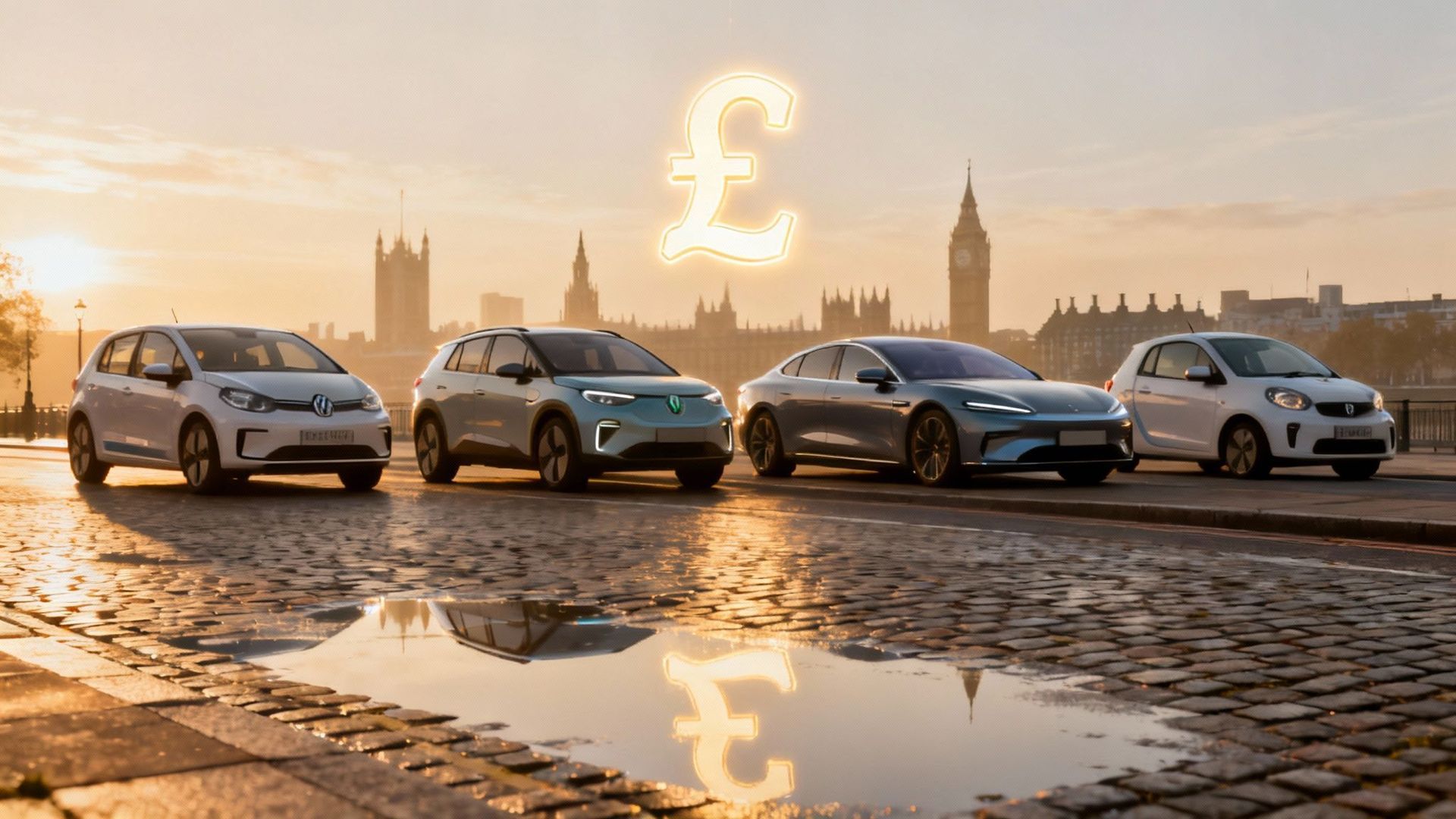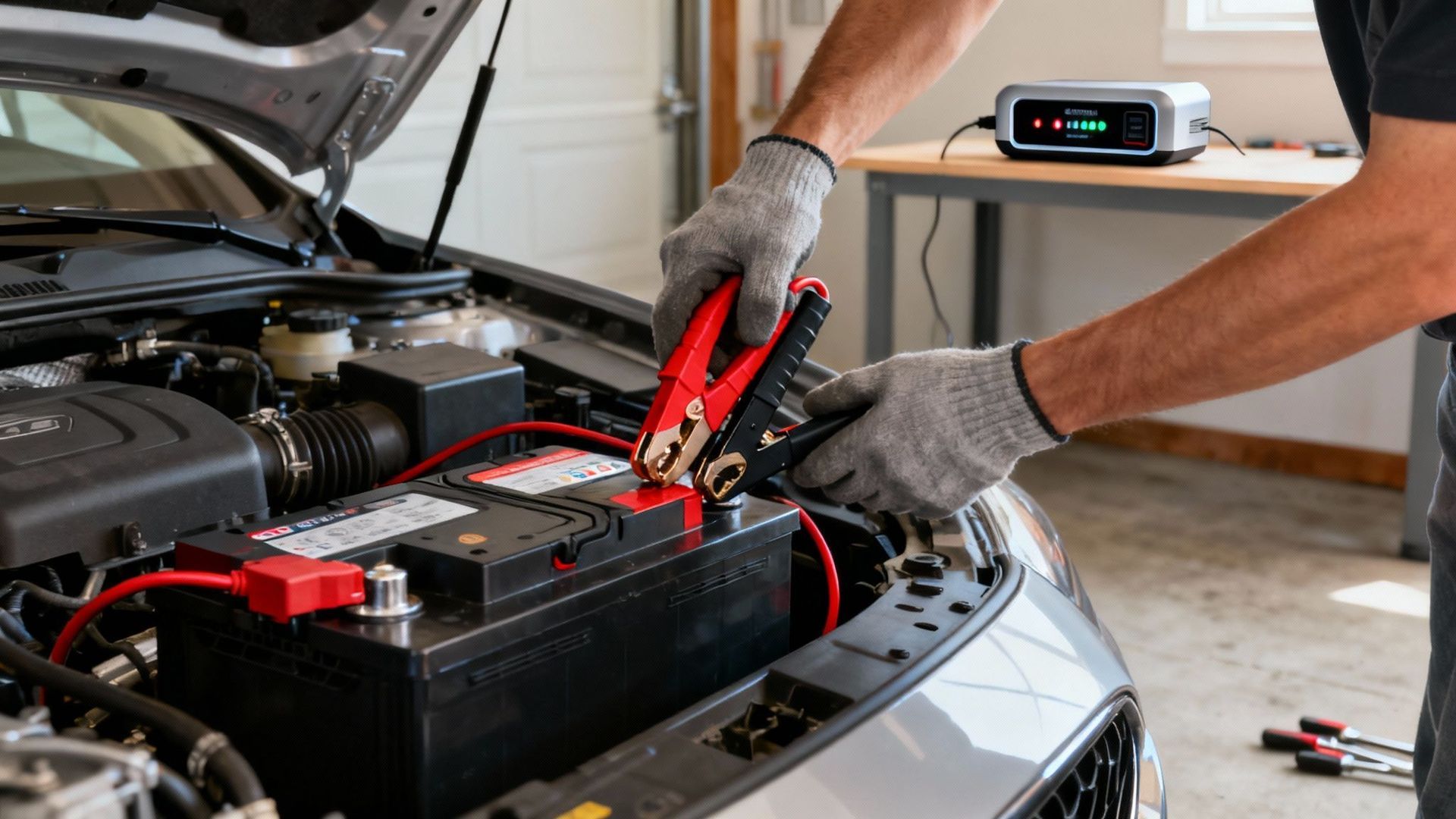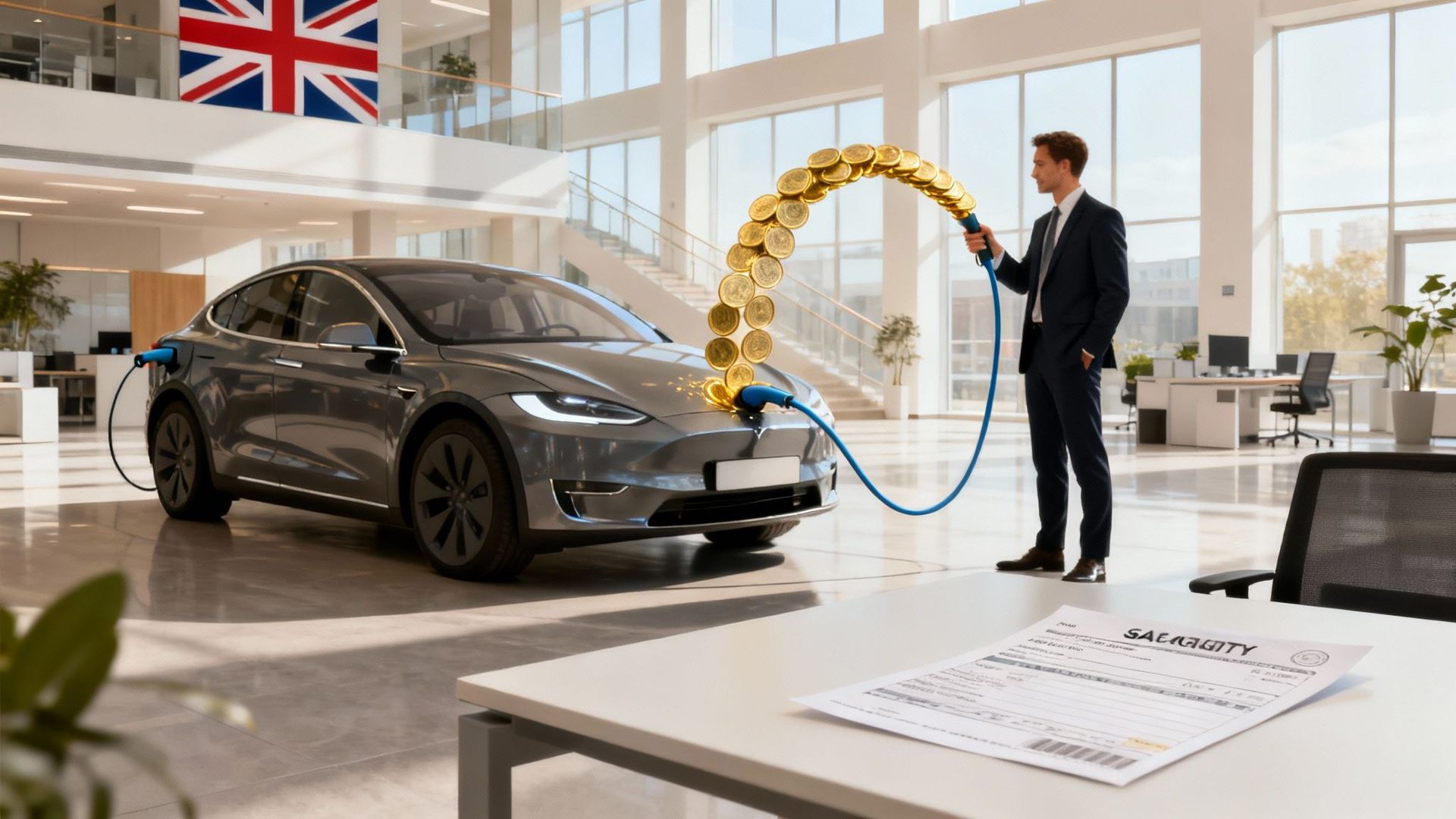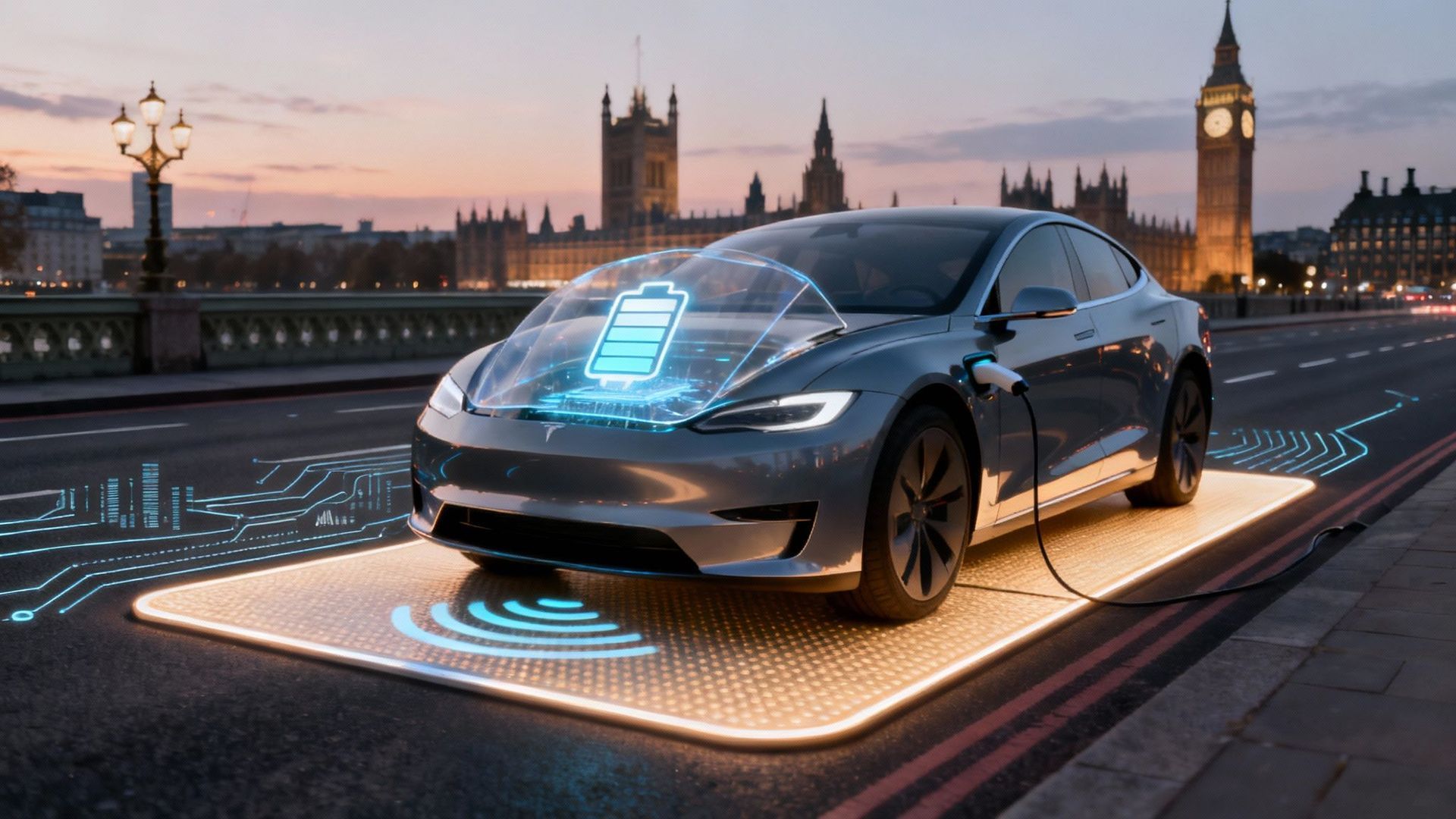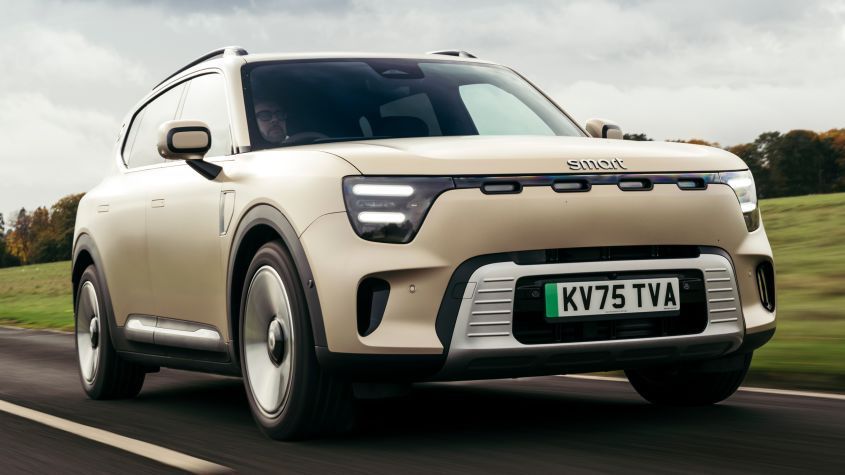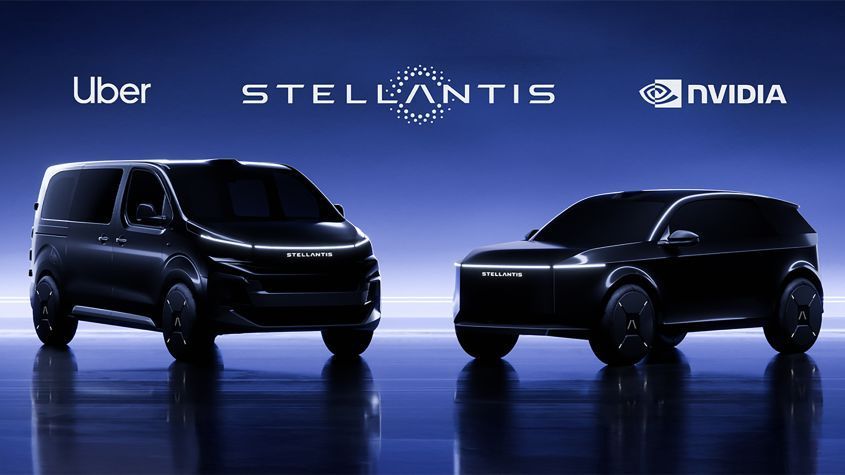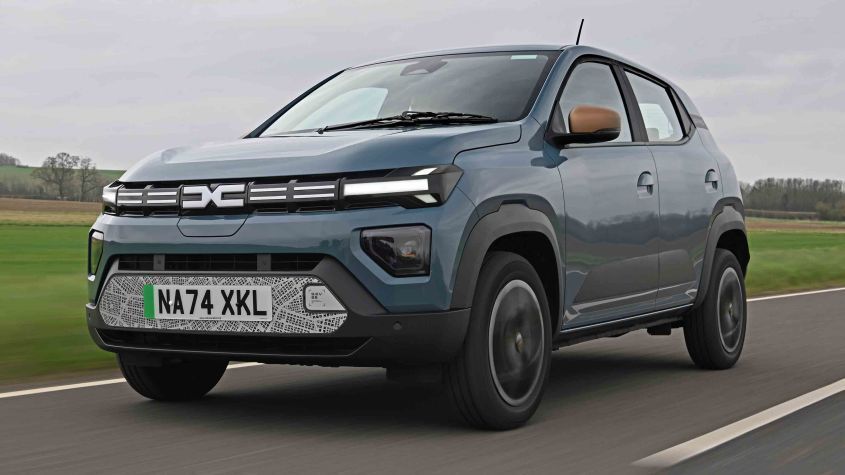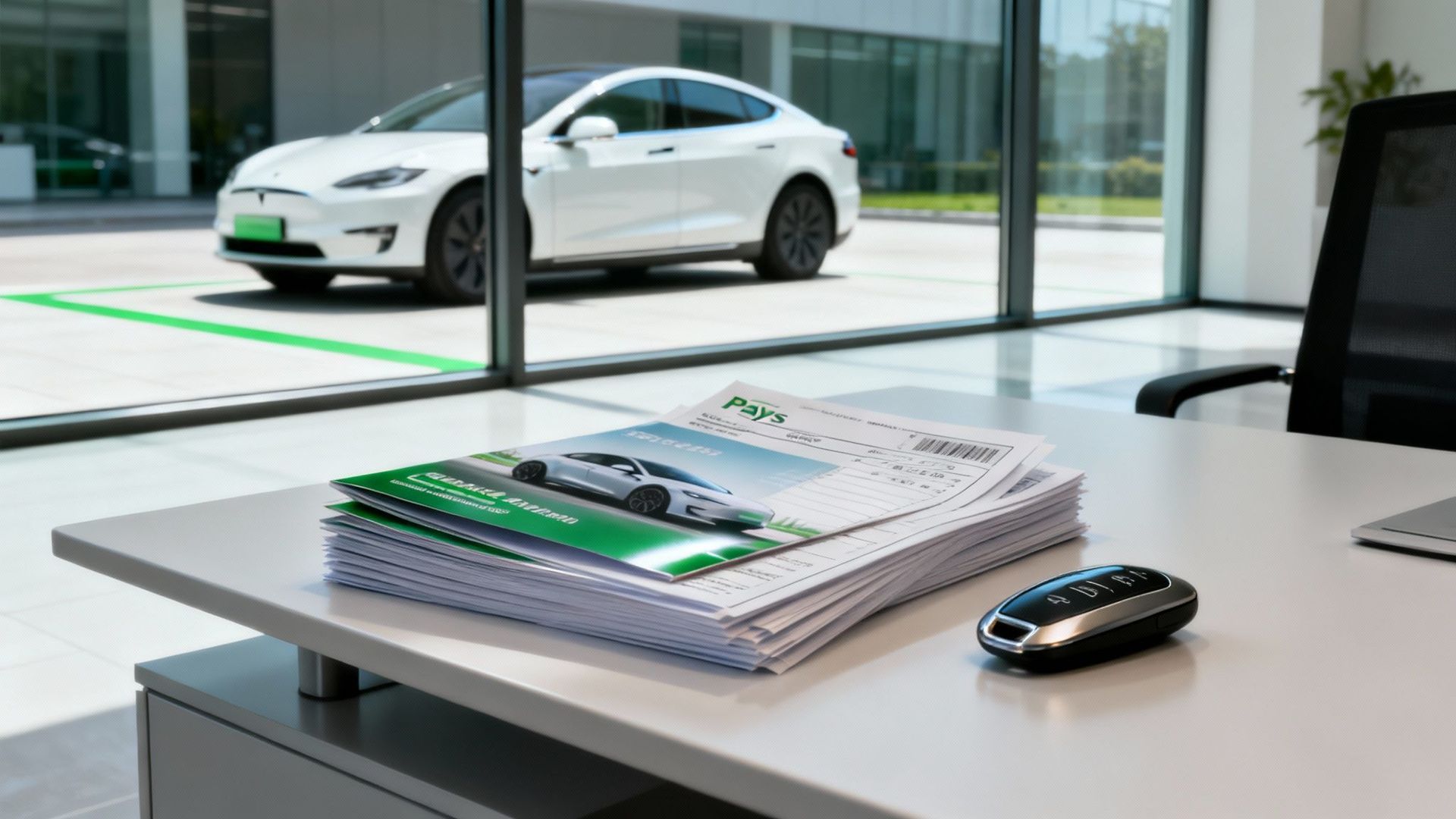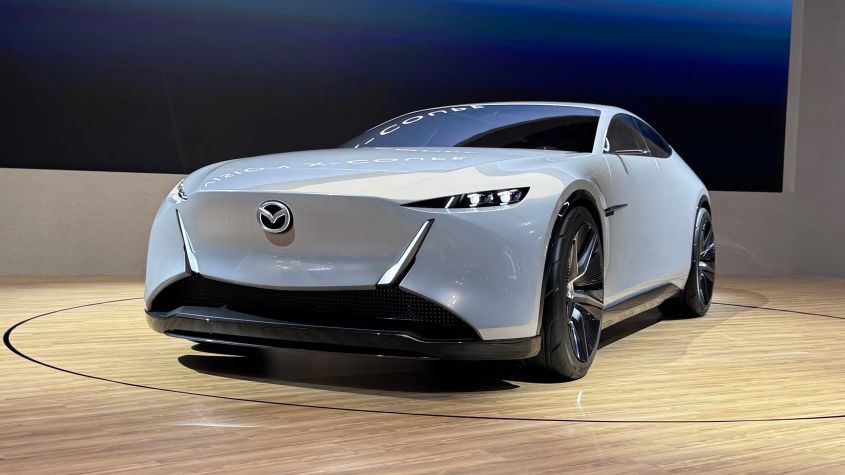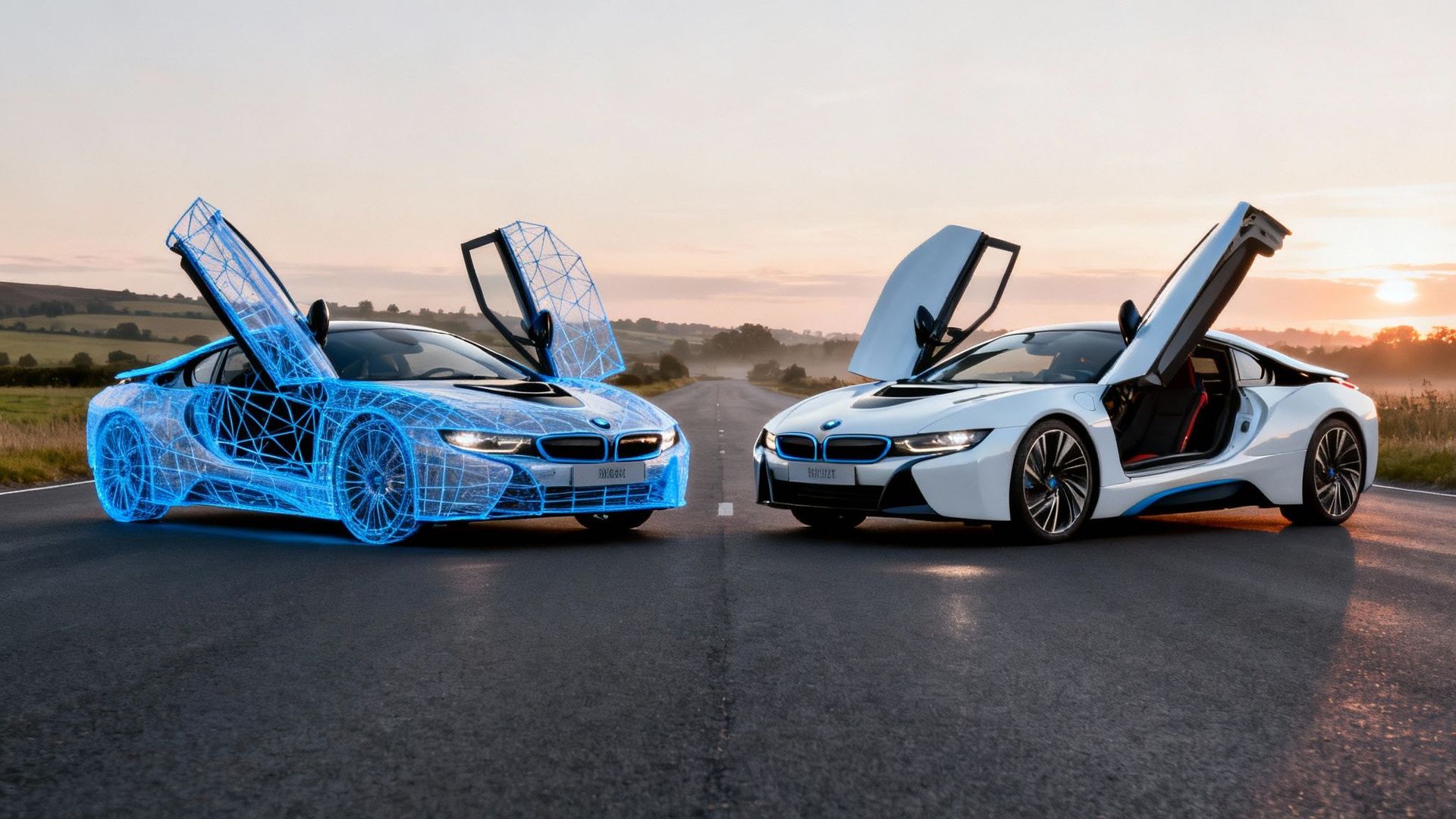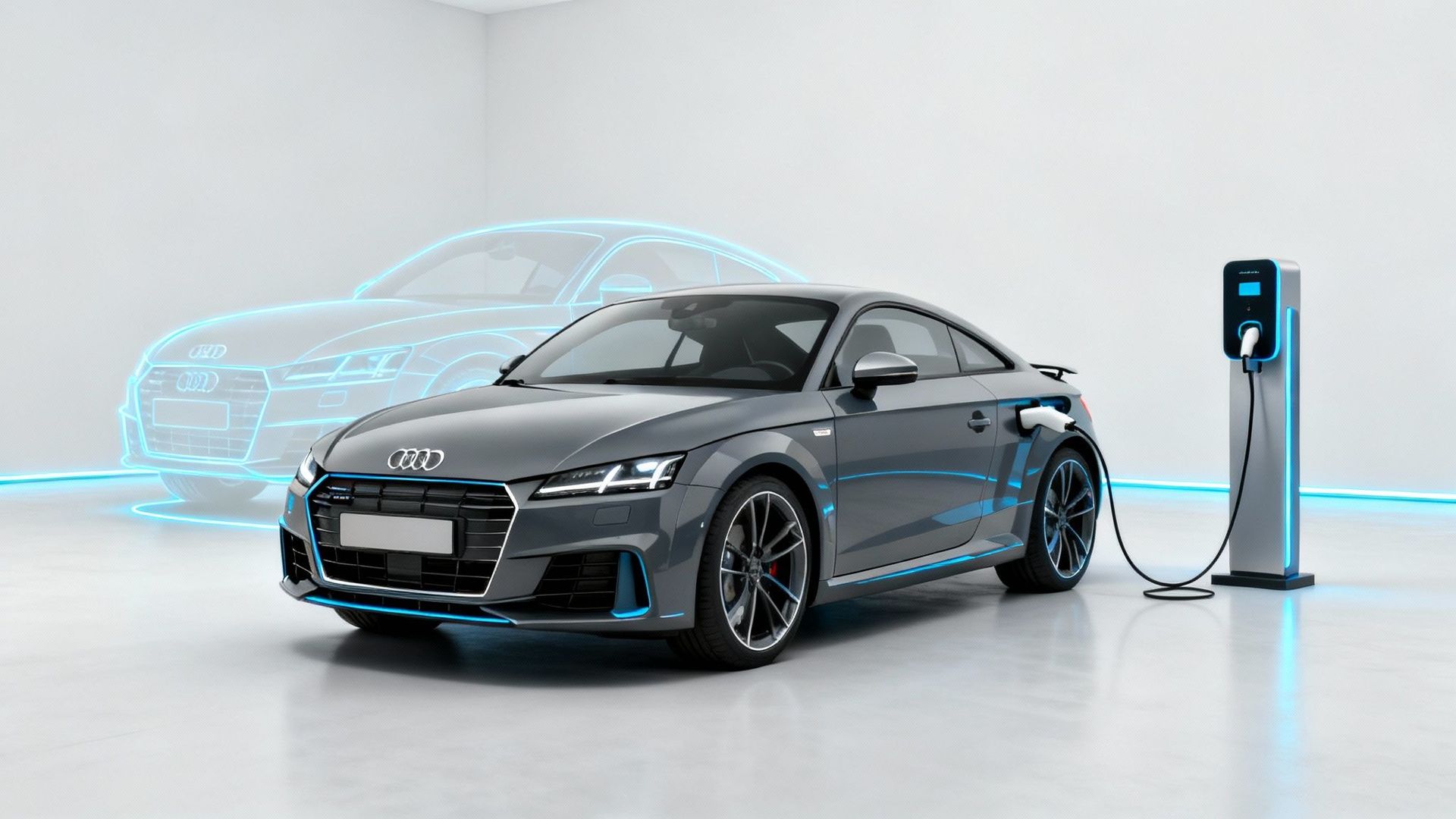UK Electric Car Range: Your Ultimate Guide to Not Getting Stranded
Let's be honest, electric car range is the number one thing that gives potential converts the jitters. It’s the big, ominous question mark hanging over the switch from petrol to electric: just how far can you really go on a single charge before you’re stranded on the hard shoulder of the M25 in the pouring rain?
Think of it as the EV equivalent of a fuel tank, only instead of a comforting needle, you have a percentage that seems to drop faster than your will to live during a Monday morning Teams call. For many, this conjures up a nightmare scenario of phoning the RAC while being stared at by disapproving cows.
What Official Electric Car Range Figures Actually Mean
When you see a shiny new electric car advertised with a colossal range figure, that number comes from something called the Worldwide Harmonised Light Vehicle Test Procedure , or WLTP . It sounds terribly official and scientific, doesn't it? As if chaps in white coats have meticulously calculated every last electron.
In reality, it's a number cooked up in a lab under perfect, repeatable conditions. Those conditions have sod all to do with a wet Tuesday in Stoke, a freezing winter morning, or a summer holiday schlep down to Cornwall with the air-con blasting and the kids screaming in the back.
The WLTP figure is best thought of as the "servings per packet" suggestion on a tin of biscuits—technically possible, but a laughable fantasy for anyone living in the real world. The first step to understanding range is accepting that the number on the box is the absolute best-case scenario, not your daily average.
Deconstructing Range Anxiety
The fear of running out of juice mid-journey even has its own trendy name: range anxiety . It's the modern-day bogeyman haunting the dreams of would-be EV drivers. But here's the thing: for the vast majority of UK drivers, it’s completely unfounded. The facts, inconvenient as they may be for the pub bores, tell a very different story.
The adoption and range capabilities of electric cars in the UK have surged in recent years. As of early 2025, the average new battery electric vehicle had a WLTP-rated range of around 290 miles . That's a huge leap forward from the glorified milk floats of yesteryear.
To put that into perspective, let's look at how we actually drive here in Blighty.
UK Driving Habits vs Average EV Range
This quick comparison shows just how ridiculously over-specced a typical EV's range is for our real-world driving needs.
| UK Driving Statistic | Distance | Average EV Range Coverage |
|---|---|---|
| Average UK Car Journey | 10 miles | One charge covers roughly 29 trips |
| Average Weekly Mileage | 127 miles | A single full charge easily covers two weeks of pottering about |
| Most Daily Commutes | <25 miles | A mere fraction of a single charge |
As you can see, for the average person, a modern EV has more than enough battery for a week or two of typical driving. The daily commute barely makes a dent.
The infographic below really helps visualise the difference between the lab-tested WLTP figures and the real-world range you'll likely experience.
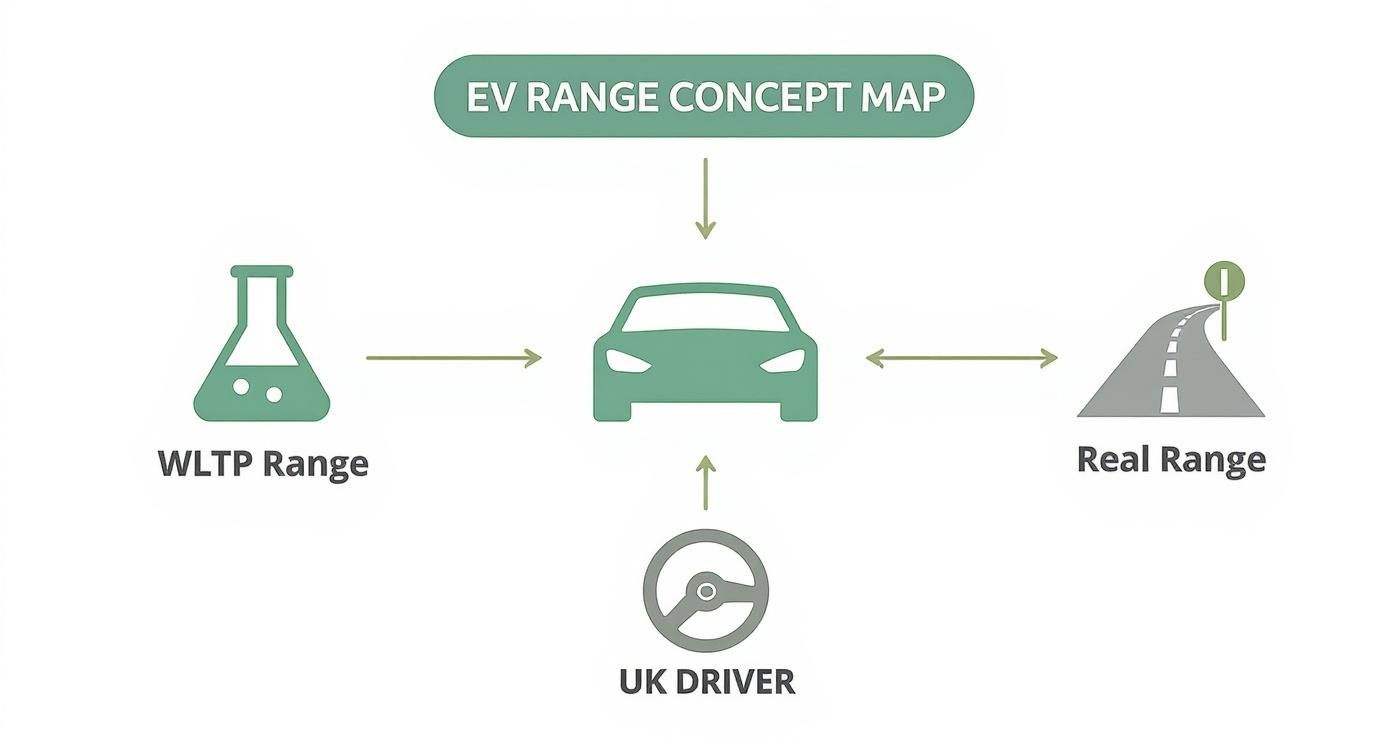
As the graphic shows, the official range is a useful starting point, but your actual mileage on grim British roads is what truly counts. The key is to shift your mindset from the theoretical maximum to the practical reality of what you need each day.
With over 1.5 million fully electric cars now on UK roads and BEVs making up roughly 21% of new car registrations in 2025, the tide has clearly turned. The technology and infrastructure are here, and the data shows that range is more than sufficient for the vast majority of us. You can learn more about the technology making this possible by exploring the latest innovations in electric vehicle battery technology. This remarkable growth is a testament to the fact that modern EVs are more than up to the task.
The Real-World Range Robbers You Need to Know About
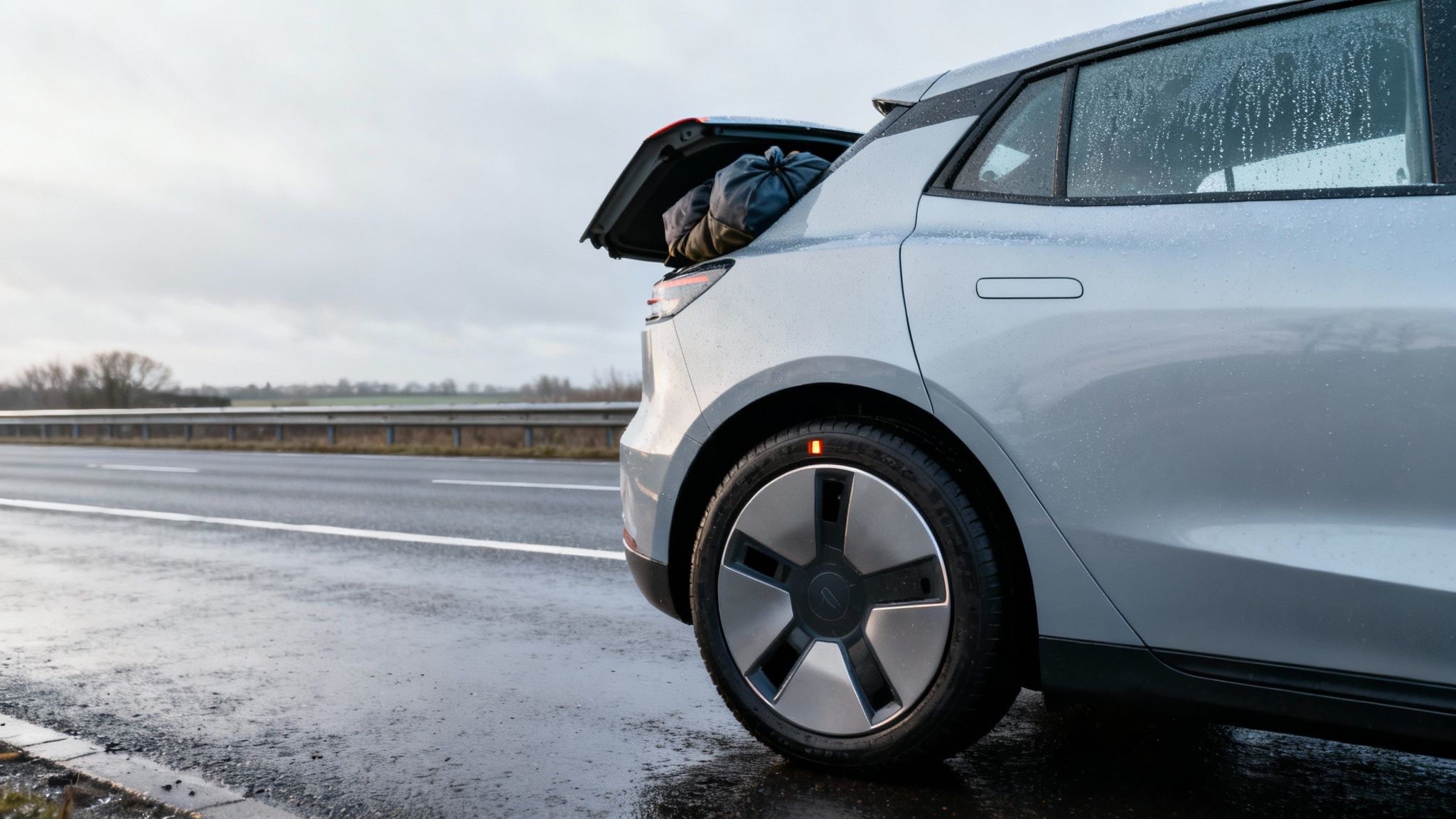
So, you’ve seen the official WLTP range figure for an electric car. Impressive stuff. But now it’s time for a reality check, because a whole host of real-world factors are queuing up to nick miles from that number.
Think of your EV’s official range like the 'miles per gallon' figure for a petrol car – it’s a brilliant benchmark achieved in perfect lab conditions, but rarely reflects what you'll get on a wet Tuesday in November.
First up on the list of culprits is the Great British weather. An EV's lithium-ion battery is a bit of a diva about its operating temperature. When the mercury drops, the chemical reactions inside the battery slow right down, making it much less efficient at delivering power. Brace yourself for a 20-30% drop in range during a proper cold snap, and that’s before you even think about touching the heater.
Driving Style and The Laws of Physics
Let’s be honest, how you drive has a huge impact. If you’re heavy on the accelerator and brake pedal, treating every traffic light like you’re on the starting grid at Silverstone, you're just chucking energy down the drain. Smooth, gentle inputs are your best friend for squeezing every last mile out of the battery.
But it's not just about being gentle; it's about speed. The physics are unavoidable here. Pushing a two-tonne car through the air at 70 mph on the motorway requires a colossal amount of energy compared to trundling around town at 30 mph . Air resistance ramps up exponentially as you go faster, making high-speed cruising the biggest single drain on your battery during a journey.
And what about the weight you're carrying? If your boot is a permanent home for old junk, sports gear, and that flat-pack wardrobe you bought last summer, it all adds up. Every extra kilogram means the motors have to work that little bit harder, which nibbles away at your range.
The Hidden Cost of Creature Comforts
It’s a freezing morning, so you jump in and crank the heating up to full blast. It feels great, but it comes at a steep price. Unlike a petrol or diesel car which uses waste heat from the engine to warm the cabin (one of the few useful things a combustion engine does), an EV has to generate that heat purely from its high-voltage battery.
A car’s cabin heater is a power-hungry beast, drawing anywhere from 3,000 to 5,000 watts . It is, by a huge margin, the most significant auxiliary power drain and the main reason your winter range plummets.
It's not just the main heater, either. Every convenience has an energy cost:
- Air Conditioning: In the summer, the A/C is just as thirsty for power as the heater is in the winter.
- Heated Seats & Steering Wheel: These are much more efficient than heating the entire cabin, but they still sip away at your battery.
- Tyre Pressure: This is a sneaky one. Under-inflated tyres increase rolling resistance, making the car work harder to move. It's like trying to cycle with a flat tyre.
The Slow Creep of Battery Ageing
Finally, there’s the silent factor: battery degradation. Just like the battery in your phone, an EV's battery will gradually lose its ability to hold a full charge over many years of use. It's a slow, natural process, and modern EV batteries are incredibly durable, with an average capacity loss of around 1.8% per year .
Still, it’s a crucial part of the long-term ownership picture. To get a better handle on this, it's well worth understanding the truth about battery health reports on used EVs.
By getting to grips with these culprits—from the weather and your right foot to the clutter in your boot—you can start to reclaim those lost miles. Recognising what drains your battery is the first step to a longer, more efficient journey.
How to Become a Range Maximising Wizard
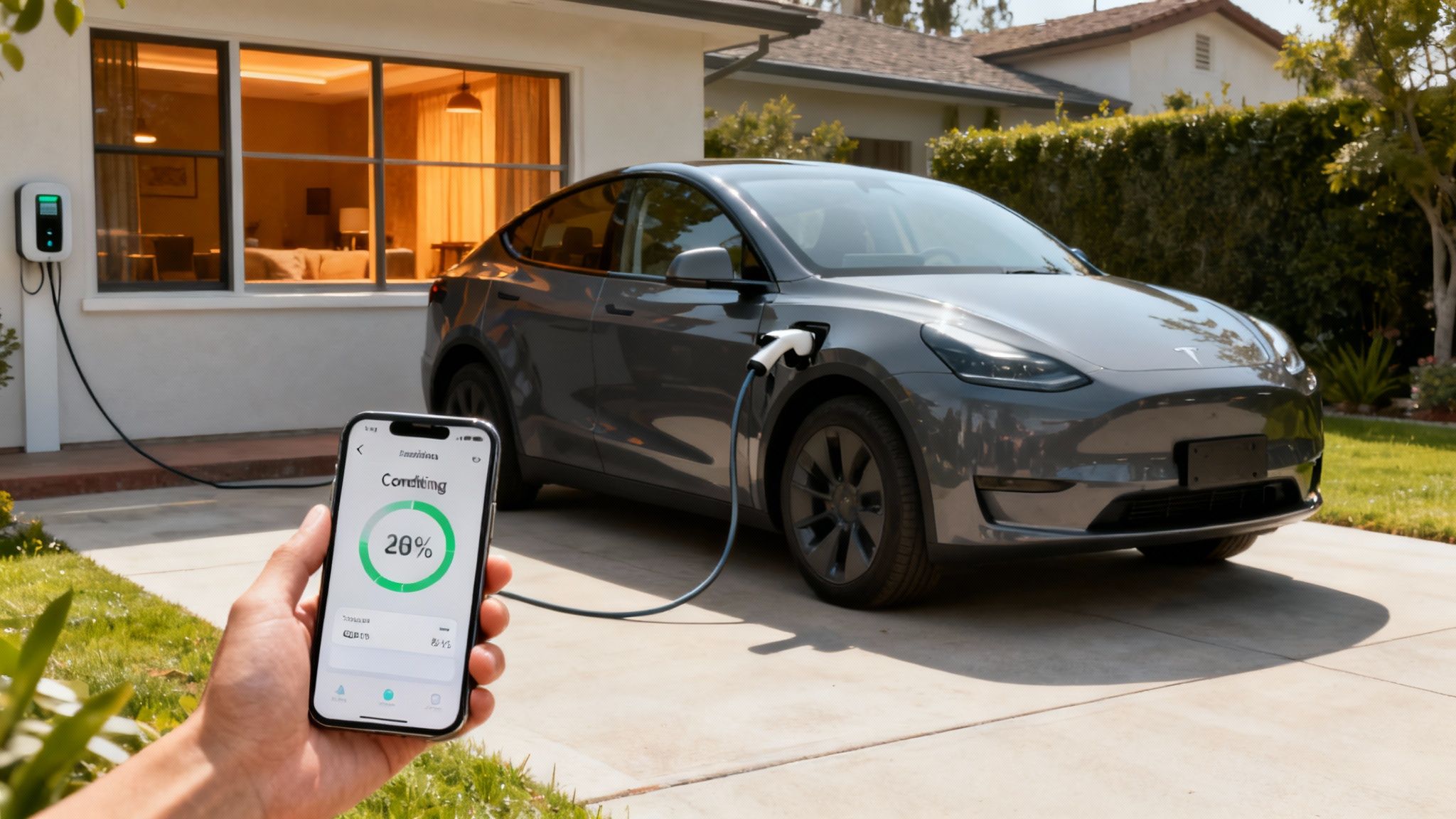
Alright, enough moaning about the villains that pilfer your precious miles. It's time to go on the offensive. This is your guide to becoming a bona fide range-maximising wizard, turning that nagging anxiety into a smug sense of superiority over your petrol-guzzling neighbours.
We're going beyond the patronisingly obvious advice to "drive slower." These are the real, actionable techniques that separate the EV novices from the seasoned pros who can coax an extra 20 miles out of a battery that's supposedly running on fumes.
Master the Art of Regenerative Braking
This is the closest thing electric cars have to actual black magic. Regenerative braking, or ' regen ', is a system that turns your car's motor into a generator when you slow down. Instead of wasting that energy as heat through traditional brake pads, it recaptures kinetic energy and sends it straight back into your battery.
Think of it this way: every time you lift your foot off the accelerator, you're essentially topping up your battery for free. It’s a game-changer, especially for driving around town with all its stopping and starting.
Most modern EVs offer adjustable levels of regen. A lower setting feels more like a traditional car, coasting freely when you lift off. A higher setting, however, engages the regen braking much more aggressively.
This leads to the holy grail of efficient EV driving: one-pedal driving . With the regen set to maximum, you can control the car's speed almost entirely with the accelerator. Lift off, and the car slows down sharply as if you're braking, all while pouring energy back into the battery. It takes a bit of getting used to, but once you master it, you'll barely ever touch the actual brake pedal.
The Magic of Pre-Conditioning
This tip is so simple it feels like cheating. The biggest drain on your battery from a standstill, especially on a cold day, is getting the cabin and the battery itself to a comfortable operating temperature. Doing this while you’re driving absolutely massacres your initial electric car range .
The solution? Pre-conditioning.
Pre-conditioning allows you to use mains electricity from your wall charger to heat or cool the car's cabin and battery before you unplug and set off. You get into a perfectly temperate car without having used a single watt of precious battery power.
It's a complete win-win. You’re more comfortable, and your car starts its journey with a full battery and an already-optimised temperature, dramatically improving your efficiency from the get-go. Many EVs let you schedule this from an app, so your car is ready and waiting for you every morning. If you're looking for the right setup at home, check out our guide on finding the best EV home charger in the UK.
Tyres: The Unsung Heroes of Range
You might not give them a second thought, but your tyres are critical. The right rubber can make a surprising difference to your overall efficiency. It all comes down to something called rolling resistance—the energy your car has to expend just to keep the tyres turning.
Here's what you need to know:
- Choose EV-Specific Tyres: When it's time for a new set, look for tyres designed specifically for electric vehicles. They are made from special compounds and have tread patterns engineered for minimal rolling resistance.
- Check Your Pressure Regularly: This is the easiest win of all. Under-inflated tyres create more drag and can reduce your range by a noticeable percentage. Check the pressures at least once a month.
- Don't Go for Style Over Substance: Massive alloys with ultra-wide tyres might look the business, but they often increase weight and rolling resistance, which is bad news for your mileage.
By combining these wizard-level techniques—mastering regen, pre-conditioning your car, and paying attention to your tyres—you can take control and significantly boost your real-world electric car range.
The UK Charging Network Is Not as Rubbish as You Think
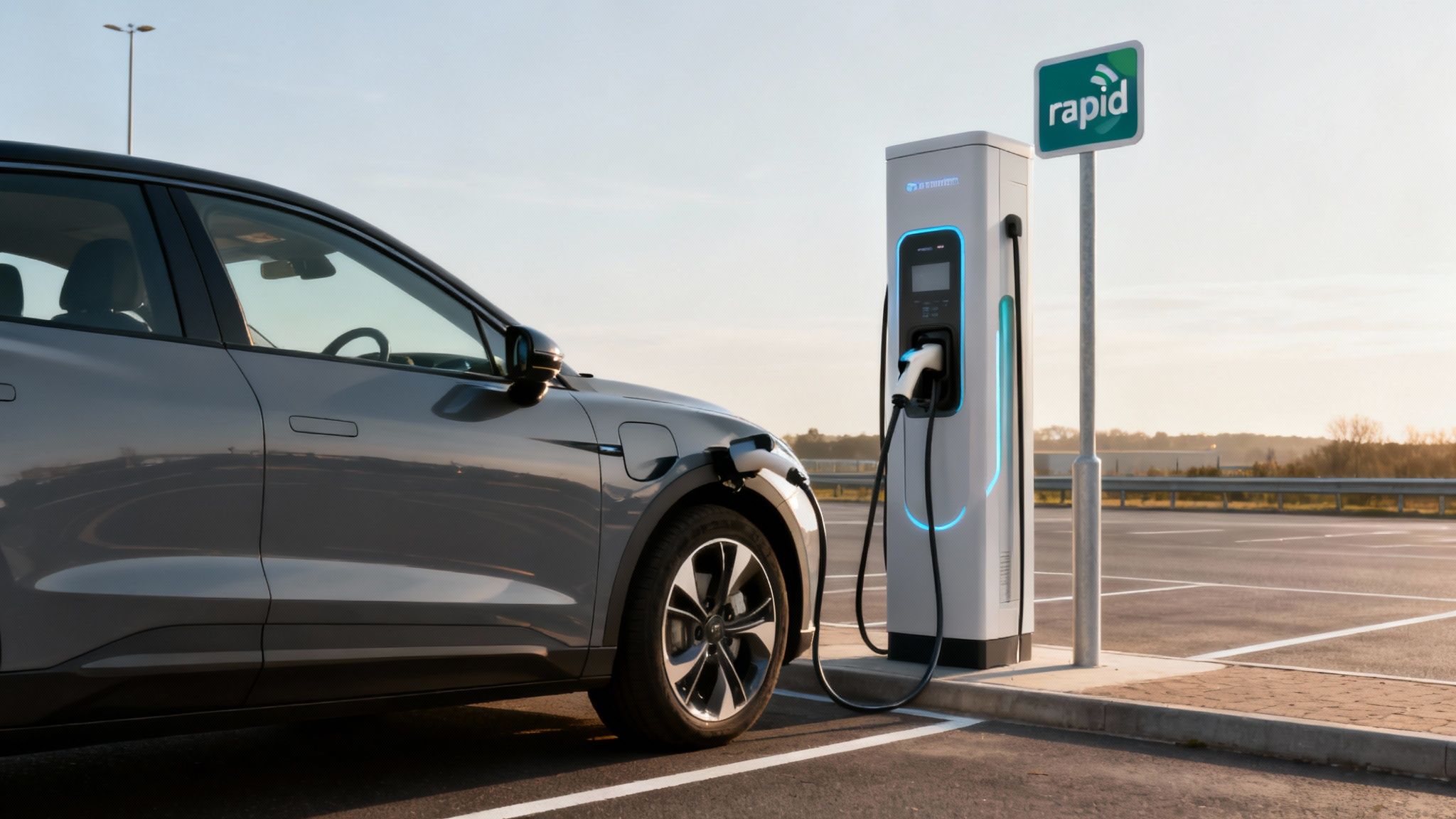
Ah, the great British public charging network. It’s a topic that seems to inspire more horror stories than a Stephen King novel. We’ve all heard them, usually from a mate down the pub who heard it from his cousin’s window cleaner: tales of a single, broken charger in the Outer Hebrides sparking a nationwide EV catastrophe.
Let’s get one thing straight. While it’s not perfect, the narrative that the UK is a charging wasteland is about as current as a dial-up modem. The reality is far less grim and a lot more promising for anyone thinking of making the switch. While everyone was busy complaining, massive investment and rapid expansion were quietly transforming the landscape.
The truth is, the UK's public charging network has grown at an astonishing rate. By January 2025, the country had 14,711 rapid and ultra-rapid chargers , including over 3,100 of the fastest ultra-rapid units—that’s a 35% increase in just one year. With around 74,611 public charging points in total, serious investment has all but eliminated urban 'charging deserts'. These days, most EV drivers are never more than 25 miles from a rapid charger on major routes. It's a huge step forward, and you can find out more about the impressive electric car range and charging stats that are making range anxiety a thing of the past.
Decoding the Charger Jargon
One of the most needlessly confusing parts of public charging is the terminology. It sounds like a menu of broadband speeds from the early 2000s, but it's actually pretty simple once you cut through the marketing fluff.
Here’s a no-nonsense breakdown:
- Slow Chargers (up to 3kW): These are basically a three-pin plug. Think of it as a trickle charge—fine for an overnight top-up at home, but utterly useless if you’re in a hurry. You’ll rarely see these out in the wild anymore.
- Fast Chargers (7-22kW): This is the most common type you'll find in car parks at supermarkets, gyms, and workplaces. A 7kW unit will add about 25-30 miles of range per hour , making it ideal for a top-up while you do your weekly shop.
- Rapid Chargers (50kW+): Now we're talking. These are the workhorses of motorway service stations. A 50kW DC charger can typically get you from 20% to 80% charge in about 40-60 minutes , depending on your car.
- Ultra-Rapid Chargers (150kW+): The big daddies of the charging world. These technological marvels can chuck electrons into your battery at a biblical rate. For a modern EV that can handle it, you could add nearly 200 miles of range in the time it takes to grab a coffee and use the loo—around 18 minutes .
The key takeaway is simple: not all chargers are created equal. Knowing the difference between a 7kW post at Tesco and a 150kW beast at Gridserve is fundamental to a stress-free EV life on the road.
Navigating the Network Maze
Yes, there are a lot of different charging networks, each with its own app, card, or payment system. For a while, it felt like collecting loyalty cards for every coffee shop chain in the country.
Thankfully, things have improved massively. Contactless payment is now standard on all new rapid chargers, and roaming agreements are becoming more common, meaning you can often use one network’s app to access another’s charger.
Apps like Zapmap provide a live map showing every public charger, its speed, network, and—crucially—if it's currently working and available. This is your essential tool for planning any long journey.
Here's a live look from Zapmap, showing the sheer density of charging points across the UK.

The map clearly shows that no matter where you are, a charging point is rarely far away, particularly along major A-roads and motorways. So, you can finally make that long-overdue trip to see your aunty in Aberdeen without packing a diesel generator in the boot.
UK Market Movers: Range Champions and Pretenders
Right, enough with the theory. Let’s get down to the brass tacks and name some names. The UK market is absolutely flooded with electric cars, all shouting about their spectacular range. But which ones are genuine long-distance heroes, and which are all mouth and no trousers?
Forget the glossy brochures and the lab-tested WLTP figures for a moment. We’re talking about real-world performance on British roads, where rain is a constant companion and a surprise traffic jam on the M25 is practically a national pastime. This is a brutally honest look at who’s who in the electric car range game right now.
The Motorway Mile-Muncher
For those who practically live in the outside lane, the undisputed king is the Mercedes-Benz EQS . It's a land yacht, sure, but it's a land yacht with a colossal battery. Its official range is a frankly ludicrous 450+ miles , and even in the real world, it comfortably delivers over 350 miles of serene, high-speed cruising.
It’s the automotive equivalent of a first-class, long-haul flight. The EQS is the car you buy if your commute is from London to Manchester and you just can't be bothered with the faff of charging halfway. The only snag? It costs more than a small house in Barnsley.
The Savvy Shopper's Champion
You don't need to sell a kidney to get decent range. For sensible money, the Hyundai Kona Electric (65kWh) is an absolute gem. It’s not the most glamorous car on the road, but its efficiency is the stuff of legend. Officially, it’ll do over 300 miles , but more importantly, it actually gets remarkably close to that in the real world.
The Kona is a masterclass in efficiency. It sips electrons like a connoisseur savouring a fine wine, making it one of the best pound-for-pound range champions you can buy in the UK.
It’s proof that a massive battery isn't everything; clever engineering and aerodynamics play a huge part. If you want maximum miles for your money without any fuss, the Kona is a brilliant choice.
The Family Hauler That Goes the Distance
Need to ferry the kids to Legoland without inducing a family-wide panic attack about finding a charger? The Skoda Enyaq is your answer. It's practical, spacious, and feels like it was designed by people who actually have children.
The larger 82kWh battery version (now badged as the 85) claims a range of around 350 miles . While you might not see that with a boot full of buggies and a roof box, it will reliably deliver 260-280 miles of motorway driving, which is more than enough for most family adventures. It’s that rare blend of genuinely useful range and the practicality modern families crave.
Real-World Range Face-Off: UK Contenders
Let's cut through the marketing fluff. Official figures are one thing, but what happens when you’re hoofing it down the M1 on a chilly Tuesday morning? Here’s our quick and slightly snarky look at what manufacturers promise versus what you’ll likely get.
| Car Model | Official WLTP Range (The Dream) | Real-World Motorway Range (The Reality) | Our Snarky Verdict |
|---|---|---|---|
| Tesla Model Y Long Range | 331 miles | 250-270 miles | Still the benchmark for many, but the real world bites back. |
| Polestar 2 Long Range | 406 miles | 280-300 miles | A seriously stylish cruiser that almost lives up to the hype. Impressive. |
| MG4 Long Range | 281 miles | 210-230 miles | Astounding value for money. The range is more than good enough for the price. |
| Porsche Taycan | 301 miles | 220-240 miles | You don't buy it for the range, but it's respectable for a battery-powered supercar. |
As you can see, the gap between the showroom promise and the tarmac reality is very real. It’s not about finding the car with the biggest number on the spec sheet, but the one whose real-world performance fits your actual life.
Frequently Asked Questions About EV Range
Right, we've waded through the technical guff and the real-world driving habits. But a few questions about electric car range just keep cropping up, often from that mate down the pub who read a headline once and now thinks he's an expert.
Let's put these common concerns to bed with some straight answers.
How Much Range Do Electric Cars Lose in Winter?
Quite a bit, frankly. When a proper, bone-chilling British winter hits, you can expect to lose anywhere from 20% to 30% of your car's official range. Cold batteries are simply less efficient, and all those creature comforts we rely on – the heater, demisters, and heated seats – draw a surprising amount of power.
The best way to fight back is to pre-condition the car while it's still plugged in. This uses power from the grid, not your battery, to get the cabin toasty, leaving more juice for the actual driving.
Do Electric Car Batteries Lose Range Over Time?
Yes, they do, but it's not the catastrophe some people make it out to be. All batteries experience a natural, gradual decline in their ability to hold a charge, a process known as battery degradation . For most modern EVs, this means a capacity loss of just a few percent, even after covering tens of thousands of miles.
It's worth remembering that manufacturers are so confident in their battery technology that they usually offer warranties for 8 years or 100,000 miles . These policies typically guarantee the battery will keep at least 70% of its original capacity.
Is It Bad to Always Charge My EV to 100%?
For your day-to-day driving, it's best to avoid it. Think of a battery like your phone – constantly keeping it at 100% can stress it over the long term. For optimal battery health, the golden rule is to keep the charge level between 20% and 80% for your regular commutes and errands.
Save that full 100% charge for when you genuinely need it, like before setting off on a long-distance road trip.
What Actually Happens If I Run Out of Charge?
First off, it won't just die on you without warning. Your car will give you a series of increasingly frantic alerts, well before the battery is empty. As you get critically low, it will enter a reduced-power "limp mode" (often shown by a turtle icon), giving you just enough speed to hopefully coast to a safe spot or a nearby charger.
And if the absolute worst happens? Breakdown services like the AA and RAC are now equipped with mobile charging vans to give you an emergency boost, providing enough range to get you to the nearest proper charging station.
At VoltsMonster , we cut through the noise to give you the real story on all things electric. For more honest reviews, guides, and EV chat, head over to https://www.voltsmonster.com.

